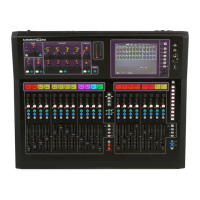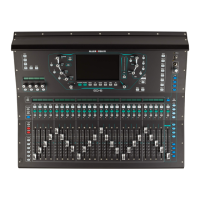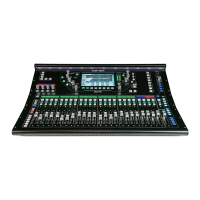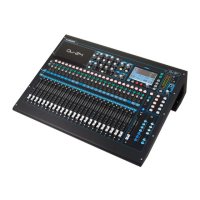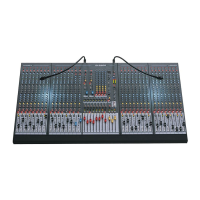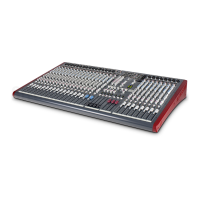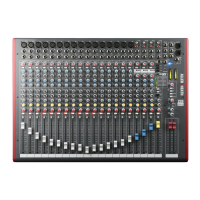To get the best performance from the system it is
important that the signal levels are correctly matched
to the console. Experiment by adjusting Channel 8 to
match the CD player.
Press
. The key illuminates red and the
active indicator
lights to show that the meters now
read the selected channel pre fader signal.
Adjust the
control
until the meters
read
around ‘0’. The loudest peaks can read up to ‘+6’. If
the red meter indicator lights then the gain is set too
high and signal clipping may result.
Adjust the
for comfortable listening
volume and check the quality of the channel signal.
This monitors the signal in mono or stereo depending
on the source. Press the
switch
to compare
between stereo and mono.
Having set the channel signal level raise the
to the normal ‘0’ position to route it to the
mix.
Press the
key to check the signal pre
fader.
Press the
switch again to turn
off. The
meters now monitor the configured output, in our
case
. Raise the
to its top ‘0’
position. The meters should now read around ‘0’.
Having set the
mix levels raise the
controls for the required amplifier volume.
This should be set to produce the loudest volume
required for signal averaging ‘0’ with occasional ‘+6’
peaks on the meters. Normal operating position of
these controls is around 12 to 3 o’clock.
Now pull back the
for comfortable
listening volume while continuing with your
experiments.
With the levels correctly set for the Channel 8 stereo
source repeat the process for the other channels. For
example plug a microphone into Channel 1.
Refer to Section 4 for instructions on using
microphones with phantom power.
Be careful to avoid acoustic feedback when using
microphones close to loudspeakers. Use directional
mics such as those with a cardiod pattern and point
them away from the speakers. Having set the channel
gain, raise the fader carefully listening for the start of
ringing or feedback. Reduce the fader level or
reposition the mic if this occurs.
Listen to signal quality and set gain using
.
Adjust the balance between the sources using the
channel
. Turn the channels on or off using
the
keys. These illuminate red when the
channel is off (muted).
Press the
select key to adjust the position of the
signals in the stereo LR mix.
The ‘soft strip’ of rotary controls beneath the display
becomes the row of
controls, one for each
channel. Adjust these to balance the signal between
left and right mix. Press
to set them all to
centre image.
You can now experiment with the processing power
of the icon. A good starting point is to adjust the
tonal characteristic of the sound using the channel
. This is a parametric type which lets you
precisely adjust the parameters of four frequency
bands. Select the equaliser for Channel 8 by pressing
. The following screen displays the default EQ
flat setting:
The soft strip beneath the display becomes the gain,
frequency and width controls together with an
illuminated in/out switch. Adjust these controls to
experiment with the effect of boosting or cutting
selected frequencies.

